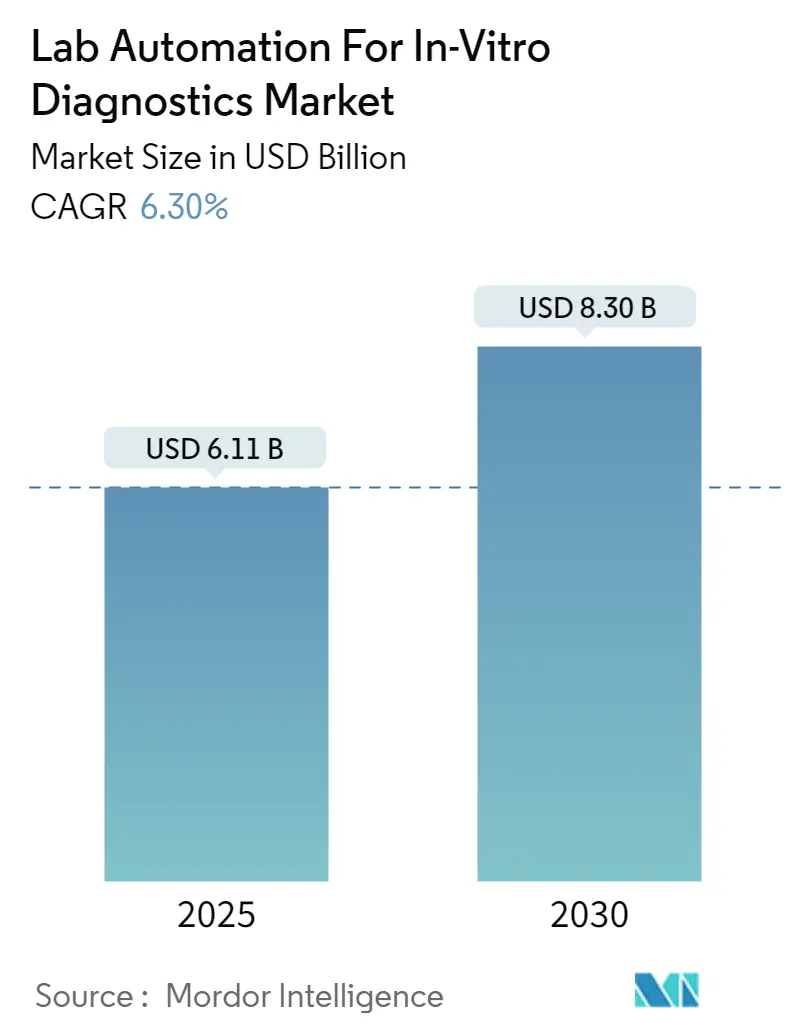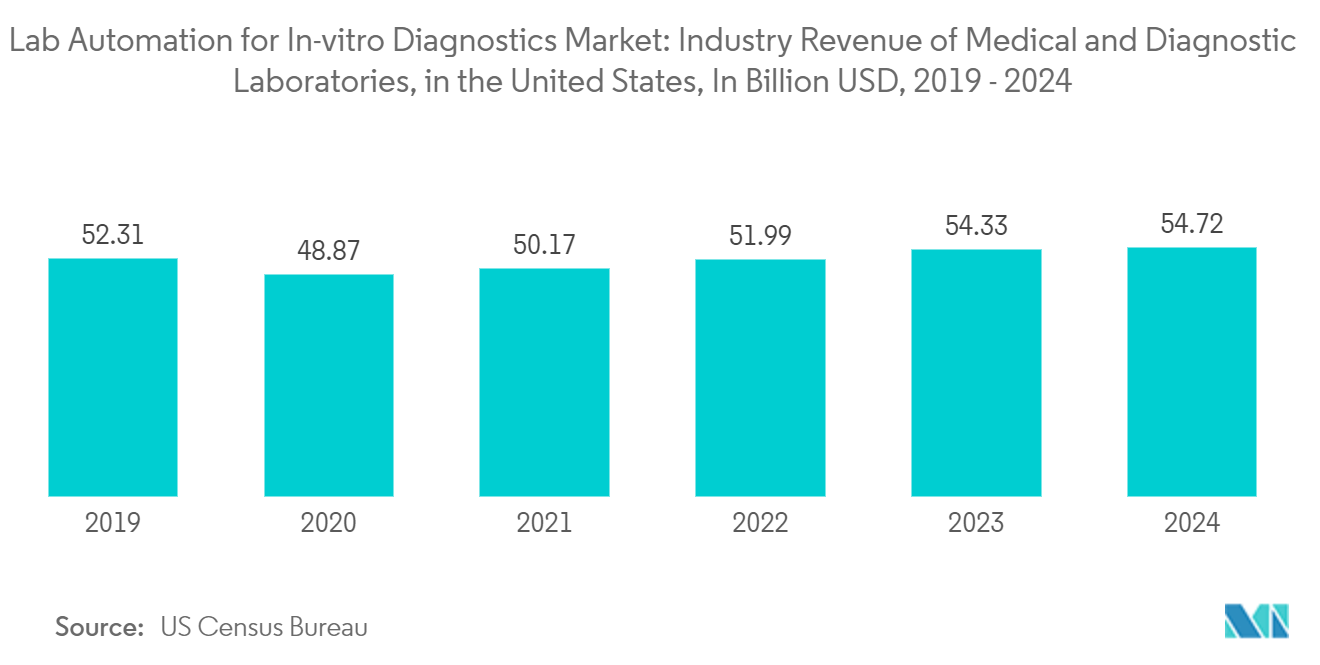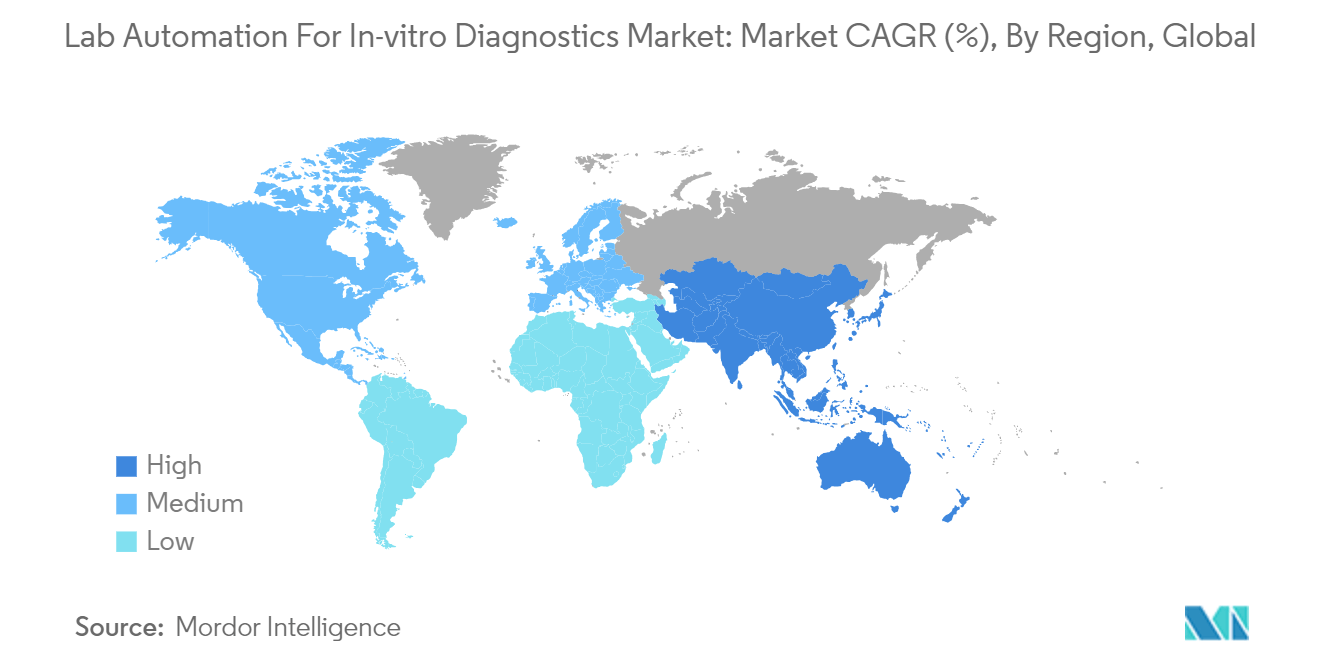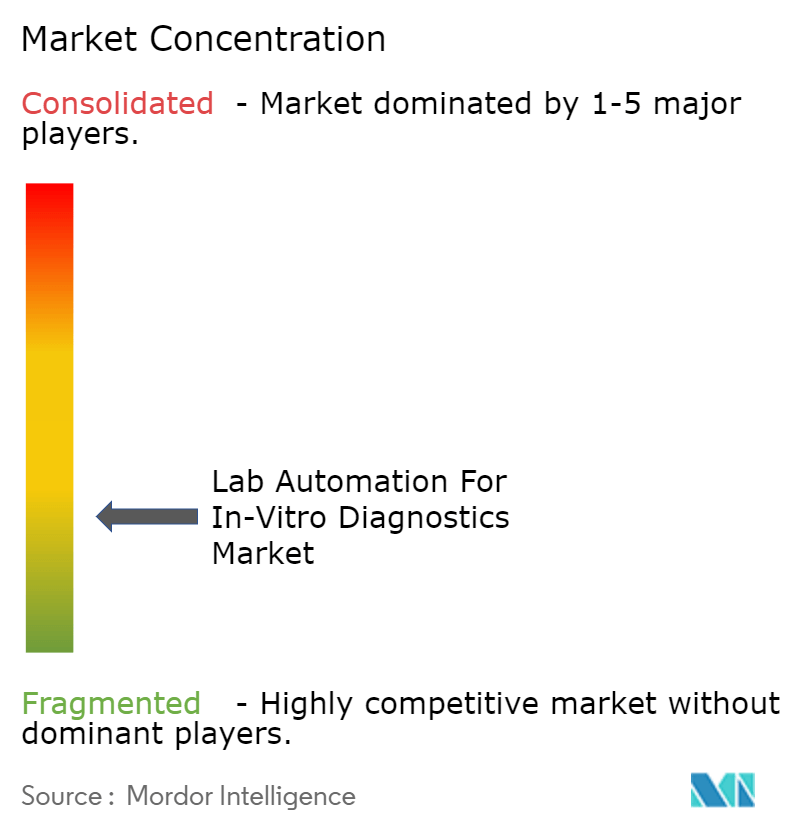
Lab Automation For In-Vitro Diagnostics Market Analysis
The Lab Automation For In-Vitro Diagnostics Market size is estimated at USD 6.11 billion in 2025, and is expected to reach USD 8.30 billion by 2030, at a CAGR of 6.3% during the forecast period (2025-2030).
- Lab automation is the process of using specimen-processing equipment to conduct clinical research. This process is carried out to develop new technology to increase productivity and decrease time cycles. In vitro diagnostics are used in various settings, including laboratories, clinics, educational institutions, diagnostic centers, and private homes.
- Lab automation is becoming more common, particularly in developing IVD medical devices. Technology is assisting in increasing the productivity and throughput of in vitro diagnostics on an unprecedented scale. The market is expected to benefit from cognitive machine-learning capabilities and Big Data to supplement diagnostic test information and technologies to enable seamless connectivity between multiple instrument systems. Automation solutions are expected to be in high demand due to technological advancements.
- The increase in R&D activities in the pharmaceutical industries and the increase in demand for process automation for food safety are driving the growth of the market. The increase in the adoption of these systems due to workflow standardization and stringent regulatory control in the healthcare sector influences the growth of lab automation for the in vitro diagnostics market.
- Biopharma companies are under constant pressure to innovate and introduce new medications to the market. Research and development (R&D) and IT leaders are increasingly adopting advanced technologies, such as R&D data platforms, robotics, connected lab instruments, cloud-based SaaS applications, and AI and ML, to modernize their operations. This is driving the market’s growth.
- The 2024 IEEE International Conference on Robotics and Automation (ICRA 2024) symbolized robotics' integration into broader societal applications. ICRA serves as a global platform, uniting robotics researchers, students, and industry partners to delve into the latest advancements and emphasize how robotics and automation are pivotal in tackling worldwide challenges.
- Automating in vitro diagnostic devices allows the healthcare sector to drastically reduce potential errors, detect infection, diagnose medical conditions, prevent disease, and monitor drug therapies more accurately. For example, during pandemic outbreaks, robotics can be used to reduce infection exposure, distribute medications and food, assess vital signs, promote border control, and automate disinfection.
- Furthermore, incorporating AI and analytical tools into laboratory workflows expands the lab automation market's profitable opportunities. However, a lack of skilled laboratory professionals and the limited feasibility of technology integration in analytical labs will challenge and hinder market growth.
- Post-COVID-19, the importance of diagnostic capabilities was highlighted, leading to increased investments in IVD technologies and lab automation to enhance testing capacity and efficiency. Moreover, innovations in automatic technologies such as AI, robotics, and machine learning have enhanced diagnostic testing speed, making lab automation an attractive investment.
Lab Automation For In-Vitro Diagnostics Market Trends
The Laboratory Segment Holds the Largest Share
- The laboratory segment holds a significant market share by providing critical information to diagnose diseases and guide therapeutic decisions. The scope of robotic surgery, the transition from open to laparoscopic surgery, and the demand for surgeons with expertise in complex robotic medical procedures are expected to expand.
- Clinical diagnostics and in vitro diagnostics (IVD) benefit from advancements in automation and robotics, such as enhanced liquid handling robot solutions rather than individual pipetting chores or other types of manual handling. Robotic ultrasound has been tested in various settings, including operating rooms, remote clinics, and space. According to the US Census Bureau, the industry revenue of medical and diagnostic laboratories is expected to reach USD 54.72 billion in 2024, compared to USD 54.33 billion in 2023.
- Robotic arms are increasingly used in research laboratories for applications requiring flexibility, efficient space utilization, and seamless integration of lab peripherals. Adoption has grown over time due to the ease with which the arms can be programmed. As a result, the market will be driven by the increased adoption of robotic arms for lab automation.
- The most common application of robotics in laboratories is machine tending or pick and place to reduce labor requirements and increase productivity. For instance, in March 2024, Abbott launched its advanced automation solution, GLP Systems Track, developed to cater to the high-volume demands of laboratories in India. This launch signified Abbott's commitment to enhancing care quality while optimizing resource utilization. Tailored to various care environments and adjustable to different laboratory sizes and patient volumes, GLP Systems Track facilitates processing many test tubes daily. Notably, this automation solution is projected to slash operational costs by over 50% compared to traditional systems, ensuring enhanced system uptime.
- Due to technological advancements and increased demand for results, laboratories utilize automated systems. Owing to its precision, improved data management capabilities, reduced repetitiveness, and eventually less human intervention, lab automation is becoming more popular, resulting in higher throughput and accuracy. For example, a robot arm for sorting blood samples decreases hospital diagnostic center personnel's workload while providing safety.
- Moreover, IoT-enabled systems provide server control and monitoring of various sensors and can be easily configured to handle additional hardware interface modules. Sensors installed in robots and loaded onto devices may aid data collection and communication with cloud servers and other devices. Furthermore, laboratories can maintain data with high levels of security while providing accurate and unaltered data via IoT.

North America is Expected to Hold a Significant Market Share
- North America dominates the market due to the presence of large pharmaceutical companies and the rapid increase in investment in the drug discovery and genomics industries. The United States is expected to record a significant growth rate during the forecast period due to the increased development of novel technologies, rapid population growth, and continuous technological advancements.
- North America has been a leader in clinical research for many years. Pfizer, Novartis, GlaxoSmithKline, J&J, and Novartis are among the major pharmaceutical companies headquartered in this region. In addition, the area has the greatest concentration of contract research organizations (CROs). Some significant CROs include Laboratory Corp. of America Holdings, IQVIA, Syneos Health, and Parexel International Corp.
- Due to the availability of government funds, stringent FDA regulations, and the growing use of molecular diagnostics in genetic disorders and cancer screening, the market in North America is expected to witness growth. For instance, in FY 2024, the President's Budget under the Department of Health and Human Services (HHS) committed to enhancing the health and well-being of Americans. The proposed budget allotted USD 144.3 billion for discretionary spending and USD 1.7 trillion for mandatory expenditures. The budget is aimed at securing a healthier, more dynamic future for all Americans by investing in extended coverage and access to care.
- The growing number of surgeries and the prevalence of various chronic diseases drive demand for automation in the clinical diagnostics industry. The American Orthopedic Surgeons (AAOS) predicts that approximately 3.0 million total knee arthroplasty surgeries will be performed in the United States by 2030. Diagnosing these and other chronic conditions necessitates sample collection, which increases market demand.
- Increased access to superior technologies, increased demand for laboratory automation, and the expansion of molecular diagnostics for genetic disorders and cancer screening in the United States may all boost market demand in North America. SmartLabs, a Boston-based laboratory-as-a-service (LaaS) leader, announced plans to open SmartLabs' advanced resourcing in Boston and the Bay Area, which is expected to become the city's most prominent life sciences research and production space upon completion in 2025.

Lab Automation For In-Vitro Diagnostics Industry Overview
- The lab automation for in vitro diagnostics market is fragmented, with influential players like Thermo Fisher Scientific Inc., Cognex Corporation, Danaher Corporation, Roche Holding AG, and Agilent Technologies Inc. Vendors in the market are embracing strategies such as partnerships and acquisitions to improve their product offerings and gain sustainable competitive advantage. For example, in October 2023, Sysmex Corporation and Fujirebio Holdings Inc. cooperated to improve their immunoassay R&D, clinical development, production, and marketing activities.
- Favorable endeavors undertaken by government and non-government bodies to improve overall healthcare services are expected to increase market growth. In October 2023, WHO published the Essential Diagnostics List (EDL), a wide list of IVD products that helps countries make decisions regarding diagnostic tools. It provides evidence-based recommendations and ensures the accessibility of essential products for target people.
- In August 2023, the Africa CDC cooperated with the Africa Development Agency-New Partnership for Africa's Development (AUDA-NEPAD) to expand access to diagnostic tests across Africa. Such initiatives are anticipated to boost market growth.
- Several lab automation platform designers have also raised funds from venture funds to solve the challenges in the drug development and testing industry. In February 2024, Monomer Bio raised USD 5.6 billion through seed funding and aims to develop an AI-powered lab automation platform that allows researchers to develop innovative treatments.
- Furthermore, the in vitro diagnostics market is subject to growing regulatory scrutiny. For instance, in July 2023, the US FDA revealed a renewed attempt to regulate laboratory-developed tests (LDTs) as medical devices. In September 2023, the US FDA made it mandatory for LDT manufacturers to comply with medical device statutes and regulations. FDA intended to enforce this in phases starting in 2024 to 2028.
Lab Automation For In-Vitro Diagnostics Market Leaders
-
Cognex Corporation
-
Roche Holding AG
-
Thermo Fisher Scientific Inc.
-
Danaher Corporation
-
Siemens Healthineers AG
- *Disclaimer: Major Players sorted in no particular order
Lab Automation For In-Vitro Diagnostics Market News
- May 2024: Roche announced an extension of its partnership with Hitachi High-Tech, solidifying their commitment to collaborate for a minimum of 10 more years. This renewed collaboration leverages the combined strengths of both companies in diagnostics innovation, engineering, and manufacturing. Over the years, their partnership has yielded groundbreaking innovations, from introducing the industry's first multi-channel analyzer to automating immunology processes. These advancements revolutionized clinical labs and played a pivotal role in helping healthcare systems overcome delivery challenges, ensuring patients receive timely and effective care.
- February 2024: Standard BioTools Inc., in line with its mission to 'Unleash tools to accelerate breakthroughs in human health,' partnered with Next Gen Diagnostics. The collaboration focuses on transforming the automation of sample preparation for pathogen whole genome sequencing. Standard BioTools planned to produce the NGD-100 as part of this exclusive agreement. This system is a tailored iteration of its microfluidics-based Biomark X9 System, designed explicitly for Next Gen Diagnostics and finely tuned for automated pathogen WGS library preparation.
Lab Automation For In-Vitro Diagnostics Industry Segmentation
In vitro diagnostics (IVD) tests are medical devices that could be reagents, techniques, instruments, or a combination of these used in vitro to examine specimens such as blood, urine, or tissue to obtain a diagnosis from assays in a controlled environment. Diagnostic tests are usually conducted in laboratories, private or public, equipped with appropriate and sometimes expensive instrumentation and staffed with trained and qualified personnel to perform the tests.
The lab automation for in-vitro diagnostics market is segmented by equipment (automated plate handler, automated liquid handler, robotic arm, automated storage and retrieval system, and analyzer), end user (academic, laboratory, and other end users), and geography (North America, Europe, Asia-Pacific, Latin America, and Middle East and Africa). The report offers market sizes in value terms (USD) for all the above-mentioned segments.
| By Equipment | Automated Plate Handler |
| Automated Liquid Handler | |
| Robotic Arm | |
| Automated Storage and Retrieval System | |
| Analyzer | |
| By End User | Academic |
| Laboratory | |
| Other End Users | |
| By Geography*** | North America |
| Europe | |
| Asia | |
| Australia and New Zealand | |
| Latin America | |
| Middle East and Africa |
Lab Automation For In-Vitro Diagnostics Market Research FAQs
How big is the Lab Automation For In-Vitro Diagnostics Market?
The Lab Automation For In-Vitro Diagnostics Market size is expected to reach USD 6.11 billion in 2025 and grow at a CAGR of 6.30% to reach USD 8.30 billion by 2030.
What is the current Lab Automation For In-Vitro Diagnostics Market size?
In 2025, the Lab Automation For In-Vitro Diagnostics Market size is expected to reach USD 6.11 billion.
Who are the key players in Lab Automation For In-Vitro Diagnostics Market?
Cognex Corporation, Roche Holding AG, Thermo Fisher Scientific Inc., Danaher Corporation and Siemens Healthineers AG are the major companies operating in the Lab Automation For In-Vitro Diagnostics Market.
Which is the fastest growing region in Lab Automation For In-Vitro Diagnostics Market?
Asia Pacific is estimated to grow at the highest CAGR over the forecast period (2025-2030).
Which region has the biggest share in Lab Automation For In-Vitro Diagnostics Market?
In 2025, the North America accounts for the largest market share in Lab Automation For In-Vitro Diagnostics Market.
What years does this Lab Automation For In-Vitro Diagnostics Market cover, and what was the market size in 2024?
In 2024, the Lab Automation For In-Vitro Diagnostics Market size was estimated at USD 5.73 billion. The report covers the Lab Automation For In-Vitro Diagnostics Market historical market size for years: 2019, 2020, 2021, 2022, 2023 and 2024. The report also forecasts the Lab Automation For In-Vitro Diagnostics Market size for years: 2025, 2026, 2027, 2028, 2029 and 2030.
Our Best Selling Reports
Lab Automation For In-Vitro Diagnostics Industry Report
Statistics for the 2025 Lab Automation For In-Vitro Diagnostics market share, size and revenue growth rate, created by Mordor Intelligence™ Industry Reports. Lab Automation For In-Vitro Diagnostics analysis includes a market forecast outlook for 2025 to 2030 and historical overview. Get a sample of this industry analysis as a free report PDF download.

.webp)


